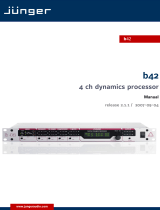Page is loading ...

www.
junger
audio
.
com
mpx
7
digital transmission processor
Manual
release 2.0.2 / 2015-10-09
mpx7

CONTENTS
CONTENTS
A – OPERATION MANUAL
1. Function description
1.1. Basic description
1.2. Block diagram
2. Installation
2.1. Unpack the unit
2.2. Power supply
2.3. Connections
2.4. Rack mounting
2.5. Operation safety
2.6. Synchronization of digital output
2.7. Audio connections
2.8. Remote Control
2.8.1. GPI Remote Control
2.8.2. Tally Out
2.8.3. Serial Remote Control
2.9. LAN interface (optional)
3. Location of parts and controls
3.1. Front panel
3.2. Rear panel
3.3. Switches and jumpers for configuration
4. Operation
4.1. Front panel operation / mpx7 keys
4.1.1. Navigation
4.1.2. Main Display
4.1.3. Menu Preset / Setup
4.1.4. User presets
4.2. Operation via web interface
4.2.1. Controller LAN
4.2.2. Parameter Settings mpx7
5. Boot display and trouble shooting
5.1. Boot display
5.2. Error messages and trouble shooting
5.3. Initialization of the unit
6. Technical specifications
7. Declaration of Conformity - CE
mpx7

CONTENTS
B – APPLICATION NOTES
1. The Junger Audio Dynamics Processor Principle
2. The Junger Audio Compressor & Expander Principle
3. The Junger Audio Processing Presets
4. Network Integration for TCP/IP Operation
5. FM-Processing d07/mpx7
5.1. General
5.2. MPX-Limiting
5.3. Pre-emphasis
5.4. Terms and definitions


FOREWORD
FOREWORD
Thank you for buying and using the transmission processor mpx7.
You have not only acquired the latest generation of digital dynamic range
processing, but also a piece of equipment which is unique in its design and
specification.
Please read this manual carefully to ensure you have all the information you need
to use the mpx7.
The unit was manufactured to the highest industrial standards and went through
extensive quality control checks before it was supplied.
If you have any comments or questions about installing, setting-up or using the
mpx7, please do not hesitate to contact us.
mpx7


A 1 –Function description
FUNCTIONAL DESCRIPTION
The mpx7 is designed for optimised mpx-power, adaptive pre-emphasis
and brickwall limiting of program signals for FM broadcast and TV
transmission.
It does provide reliable protection of transmission paths against overload
at the output of studios, OB vans as well as satellite up-links. The device
operates fully digitally and, besides AES/EBU interface, it makes use of
high end 24bit A/D converters so that digital dynamic processing is
possible for analog as well as digital signals.
The dynamic range processor principles developed by Junger Audio
enable level managing devices like compressors, AGC and limiters to be
produced with exceptionally high audio quality, without coloration,
pumping, breathing, distortion or modulation effects sometimes
associated with this type of processor.
In short, almost inaudible processing - with ease of use.
The unit is easy to operate and requires only a limited number of settings
to be made by the user to achieve optimum results. All other parameters
necessary for inaudible processing are continuously automatically
controlled in response to changes in the programme signal.
1.1
BASIC
DESCRIPTION
A
1

A 1 – Function description
features
2-channel digital audio amplifier and limiter for broadcast transmission
signals
audio signal processing in consideration of pre-emphasis and MPX-Power
Digital I/Os, AES/EBU format
24bit ADV and DAC
Stereo and dual channel mode
Parallel and serial remote control
1.2
BLOCK
DIAGRAM
block diagram digital transmission limiter mpx7
Further description of the processor principles see
Application notes B!

A 2 –Installation
INSTALLATION
The digital audio level processor mpx7 was carefully packed in the
factory and the packaging was designed to protect the equipment
from rough handling. Please examine carefully the packaging and its
contents for any signs of physical damage, which may have occured
in transit.
The digital audio level processor mpx7 is a device under the safety
category Schutzklasse 1 in keeping with the VDE 0804 standards and
may only used with power supply installations built according to
regulations.
Check the voltage details printed at the rear panel are the same as
your local mains electricity supply.
The digital audio level processor mpx7 is equipped with standard
connectors (see also chapter 3).
Before connecting the digital audio level processor mpx7 switch the
power off at all connected units.
The digital audio level processor mpx7 is made as standard 19“ unit
(EIA format). It occupies 1 RU (44 mm height) space in a rack. Please
allow at least additional 3“ depth for the connectors on the rear panel.
When installing the unit in a 19“ rack the rear side of the unit needs
some support, especially for mounting in flight cases.
The digital audio level processor mpx7 should not be installed near
units which produce strong magnetic fields or extreme heat. Do not
install the audio processor directly above or below power amplifiers.
If, during operation, the sound is interrupted or displays no longer
illuminate, or if abnormal odor or smoke is detected immediately
disconnect the power cord plug and contact your dealer or Jünger
Audio.
2.1
UNPACK THE UNIT
2.2
POWER SUPPLY
2.3
CONNECTIONS
2.4
RACK MOUNTING
2.5
OPERATION
SAFETY
A
2

A 2 –Installation
The digital transmission processor mpx7 has a digital signal output.
For the problem-free combination of following digital devices, the
digital signal processing can be locked to an external clock reference.
The selection of the corresponding sync source is made in the SYNC
MODE menu during setup. If the chosen sync input is connected with
the sync signal, this signal is used for synchronization automatically.
All sync sources can be used for locking A/D-converters at the
analogue inputs as well. The digital output signal can be clocked with
the following clock frequencies:
INTERNAL locks both the A/D-converters and the digital output with
the internal reference 44,1 or 48 kHz. Digital inputs are
connected via sample rate converter
AES INPUT locks with the clock frequency of the input signal at
digital input CH 1/2 (AES/EBU, 44,1...48 kHz)
EXT AES locks with the AES signal at the sync input
(AES, 44,1...48 kHz) Digital inputs are connected via
sample rate converter
EXT WCLK locks with the word clock signal at the sync input
(WCLK, 44,1...48 kHz) Digital inputs are connected via
sample rate converter
optional:
EXT VIDEO locks with black burst at sync input (internal 48 kHz)
Digital inputs are connected via sample rate converter
The analog audio inputs are RFI filtered and analogue outputs are
balanced and floating like transformer coupled devices. All the audio
connectors are via rear panel mounted connectors. Standard XLR
connectors are used. These are always wired to the AES standard:
pin 1 X Screen screen
pin 2 L Live audio 0°
pin 3 R Return audio 180°.
Balanced connections are preferred whenever the other equipment
provides balanced inputs/outputs. All line level connections should be
wired with twin screened cable for low noise and reliability. The
screens of the cable should be connected at one end only. Input cable
screening therefore needs to be derived from the signal source end as
pin 1 is ground lifted at low frequencies for the inputs.
If the equipment driving the digital audio level processor mpx7 has
unbalanced outputs then you will need to add a wire jumper such that
the screen connection of Pin 1 of the XLR is shorted to Pin 3.
If the equipment being connected to the mpx7 have only unbalanced
inputs, then we recommend still to use a balanced (ie. 2 core shielded
cable) cable where Pin 1 and Pin 3 are connected in the cable ends
away from the digital audio level processor mpx7.
2.6
SYNCHRONIZATION
OF
DIGITAL OUTPUT
2.7
AUDIO
CONNECTIONS

A 2 –Installation
The digital transmission processor mpx7 can be remote-controlled by
means of parallel GPI contacts.
use : remote-controlled changeover of presets
connector: D-SUB 15pin, female
Pin assignments
Connector : D-SUB 15pin
female panel jack
Pin assignment of the connector :
Pin Signal name Functions
1 GPI 1 in Defined by mpx7 config
2 GPI2 in Defined by mpx7 config
3 GPI3 in Defined by mpx7 config
4 GPI4 in Defined by mpx7 config
5 GPI5 in Defined by mpx7 config
6 GPI6 in Defined by mpx7 config
7 GPI7 in Defined by mpx7 config
8 GPI8 in Defined by mpx7 config
9 +5V 110 Ω
10 GPI 1/2 common
11 GPI 3 common
12 GPI 4 common
13 GPI 5 common
14 GPI 6Common
15 GPI 7/8 common
Shield GND
Electrical specification:
GPI input potential free by opto-coupler in line with
a current source
ON: -3.5…-30V between GPIx input
and GPx common
OFF : less then 1.5V betwee GPIx input
and GPIx common
Signal duration must be at least 50msec.
Note : An internal auxiliary voltage feed of +5V is available on pin 9
via a 110 Ω resistor. Ground is available from the shield of the connector
only! When using the auxiliary voltage feed, there is no electrical isolation
given anymore and the risk to inject unwanted noise is high!
Important Note : You must take care about the polarity of the external
voltage applied to the GPIs. Wrong polarity may destroy electronic
components and may cause fire inside the MPX7!
2.8
REMOTE
CONTROL
2.8.1
GPI REMOTE
CONTROL
(PARALLEL
REMOTE)

A 2 –Installation
The digital audio level processor mpx7 can transmit specific device
statuses via parallel Tally lines.
use: Control of the mpx7 status
Connector : D-SUB 25pin
female panel jack
Pin assignment of the connector :
Pin Signal name Functions
1 Tally 1 normally closed
2 Tally 1 normally opened Defined by mpx7 config
3 TALLY 2 common
4 Tally 3 normally closed
5 Tally 3 normally opened Defined by mpx7 config
6 TALLY 4 common
7 Tally 5 normally closed
8 Tally 5 normally opened Defined by mpx7 config
9 Tally 6 common
10 Tally 7 normally closed
11 Tally 7 normally opened Defined by mpx7 config
12 TALLY 8 common
13 + 5V 110 Ohm
14 TALLY 1 common
15 Tally 2 normally closed
16 Tally 2 normally opened Defined by mpx7 config
17 TALLY 3 common
18 Tally 4 normally closed
19 Tally 4 normally opened Defined by mpx7 config
20 TALLY 5 common
21 Tally 6 normally closed
22 Tally 6 normally opened Defined by mpx7 config
23 TALLY 7 common
24 Tally 8 normally closed
25 Tally 8 normally opened Defined by mpx7 config
Screen GND
Electrical specifications:
Tally output relay : common / normally closed / normally opened
24V - 1A
125V - 0,5A
P
max
= 62,5VA
2.8.2
TALLY OUT

A 2 –Installation
The digital audio level processor mpx7 can be remote-controlled by
means of serial remote RS-232/422.
use : remote-controlled changeover of presets
protocol: available on request
Connector : D-SUB 9pin
female panel jack
Pin assignment of the connector in serial interface mode :
Pin Signal name Functions
1 Rx + RS422
2 TxD RS232
3 RxD RS232
4 NC not used
5 GND Ground
6 Rx - RS422
7 NC not used
8 Tx - RS422
9 Tx + RS422
Pin assignment in CAN-bus mode :
Pin Signal name Functions
1 NC Not used
2 CAN-l CAN-bus low signal
3 NC Not used
4 NC Not used
5 GND Ground
6 GND Ground
7 CAN-H CAN-bus high signal
8 NC Not used
9 NC Not used
This connector has multiple functions. It can be either used as a serial interface
connector serving the RS232 or RS422 format (J2, internal jumper selected).
Electrical specification:
signal in-/outputs TTL-level
2.8.3
SERIAL REMOTE
CONTROL
(RS-422)

A 2 –Installation
Connector : RJ 45 with status LEDs
8 pin panel jack
Pin assignment of the connector :
Pin Signal name Functions
1 TX + Ethernet send
2 TX - Ethernet send
3 RX + Ethernet receive
4
5
6 RX - Ethernet receive
7
8
9
Electrical specifications: 100Mbit/s auto negotiation port
Application remarks :
This port allows remote control of the mpx7 by TCP/IP over Ethernet.
Setting up the network configuration is described in B 6.
The Ethernet Controller features operation via web browser. Please refer to A
4.2 “Operation via web browser”.
2.9
LAN INTERFACE
For details pls. refer to B 4 “Network integration”, A
4.2 “Operation via web interface

LOCATION OF PARTS AND CONTROLS
A
3
PRESET
switch :
Load / save / edit presets
SETUP
switch :
Device settings / Parameter editing
Status display :
Gain Change
Compressor
Peak-Lim
MPX-Lim
Output-Level
MPX-Power
ESC
CURSOR UP
CURSOR DOWN
ENTER
3.1.
FRONT
PANNEL
3.2
REAR
PANNEL
Analog I/O
Analog level adjustment
GPI
15 pin female connector
EXTERNAL SYNC IN
Word clock
Video
AES
WORDCLOCK OUT
REMOTE INTERFACES
9 pin Female connector :
RRS 232 / CAN
RJ 45 connector :
Ethernet
Digital I/O
AES / EBU
Tally out
25 pin female

POWER INPUT
IEC mains input connector 85-264V, 50/60 Hz with integrated fuse
REMOTE
serial remote interface RS-422 (232)
connector: 9pin SUB-D, female
GPI
parallel remote interface
TALLY-out open relais contact
connector: 25pin SUB-D, female
GPI-in +3,5…+30V potential-free
connector: 15pin SUB-D, female
SYNC
SYNC IN input for ext. sync signal (AES 3 format, 75 Ohm, unbal)
or video sync signal (blackburst, 75 Ohm, unbal) or
wordclock sync signal, TTL level, unbal
connector: BNC socket
WCLK OUT output for word clock (system clock of d07)
connector: BNC socket
DIGITAL IN
input for AES/EBU standard format
connector: XLR female panel jack
DIGITAL OUT
output for AES/EBU standard format
connector: XLR male panel jack
ANALOG IN/OUT
Analog input to 24 bit A/D-converter
Input floating balanced, XLR connector female
Analog output from 24 bit D/A-converter
Output floating balanced, XLR connector m
Some basic settings can be made by switches and jumpers at the internal circuit
boards of the unit. These settings can occur general changes for operation and should
made by qualified engineering staff only.
Internal
To set any internal jumper or switches it is necessary to open the unit.
PLEASE DO NOT MAKE ANY ALTERATIONS WITH THE MAINS STILL
CONNECTED TO THE UNIT!
Loosen the screws on the top cover and remove. Then you can see all jumper and
switches as shown in the drawing below. After setting of jumper or switches
reassemble the unit in opposite order.
3.3
Switches and
Jumpers for
Configuration

Selection of the serial remote interface
J2 – RS-232 / RS-422: Selection of the serial remote interface (see 3.8.3)
J3 – A / B: for factory use only, set to A
calibration of the analog in-and outputs
At our factory the d06 is calibrated German broadcast standard +15dBu = 0dBFS. If
you want to use a different referencer standard (say +24dBu = 0dBFS) you can change
the setting via dip switches on the main board of the d06.
The switches are near the analog input and output hardware on the PCB.
With factory setting of +15dBu=0bBFS the dip switch “+15dBu” will be turned ON.
To change the setting to another standard you just have to slide this dip switch to
the right (OFF) and slide the needed dip switch that corresponds to the reference
standard you are using to the left (ON).
Make sure that there is always just ONE dip switch turned ON!
Exception: They may all be OFF if you are using a CUSTOM reference level
CUSTOM Refernce Level (using Switch 6 ADJ)
If none of these stansard reference settings correspond to your needs you can set
the refernce to a CUSTOM level by adjusting the input sensitivity by the two
potentiometers (L and R) next to the analog input and output connectors at the rear
of the box.
This should only be done by experienced engineers with measuring instruments!
Main board
J2
232/422
D06/07
J3
A/B
DSP card

To set the reference level manually, follow these steps:
1. Set all dip switches to “OFF” except #6, ADJ. –set it to ON
2. Adjust the potentiometers to the desried CUSTOM reference (setting). For this you
need to feed the analog input with a known refernce level and measure the digital output.
Make sure that the DSP processing is bypassed, otherwise there could be DSP gain
active!
3. When the adjustments are complete, ‘capture’ the custom settings by setting dip switch
#6 to OFF.
Otherwise your reference level could be changed by accident at the potentiometers.
rear of the box. This should only be done by experienced engineers
with measuring instruments! After having adjusted the input level bring
the dip switch back to the “OFF” position.

A 4.1. – Front Panel Operation
Operation
The mpx7 transmission limiter is very easy to use.
You can do all settings with the keys on the front of the device or via
webinterface. Additionally GPI/O’s can be used for switch/signalization
of settings.
The mpx7 uses two groups of data, in the SETTINGS area to set up
device functions (selection of an input, synchronization or input of a
device name) and in the PARAMETER area to control the signal
processing (setting up processing parameters, MPX-limiter, etc.).
SETUP directs to the set up menus. Here one can select between
SETTINGS for device related settings and PARAMETER for signal
processing settings.
PRESET directs to loading, saving and editing of one of the
user PRESETs.
All current data is kept in a non volatile memory. Therefore they are
immediately available when turning on the device. All changes to a
parameter are effective immediately. Pressing ENTER will approve it.
By pressing ESC the changes will be rejected and the display returns
to the parameter menu.
Loading of a PRESET will immediately carry over the values into the
operating memory. By clicking free cross fade they will be effective
immediately.
There is the possibility to edit and store PRESETs in the back ground,
without taking them over into the operating memory to prepare the
device for a different kind of program that is awaited.
NAVIGATION through menus of the mpx7 is done by the
ENTER
ESC
keys :
ENTER directs into the next possible navigation level
- exit settings
- stores altered values
- directs back to the previous navigation level
ESC abort (changes are rejected)
- back to the previous navigation level
- scrolling through the navigation level
and - switching status like ON or OFF
- altering of values
A
4
4.1
FRONT PANEL
OPERATION
mpx7 keys
4.1.1.
NAVIGATION

A 4.1 – Front Panel Operation
When you switch on the mpx7 the main display will show you the current
controller software and hardware version of your device. You can always
have a look on it by pressing ENTER if you are not in a menu (SETUP or
PRESET).
After a few seconds the main display switches to showing the input level
(R/L).
By pressing you can step through the following status details:
Display
Description
MAIN DISPLAY
MPX7 C:xx D:yy
Device, Controller software, DSP version
L: xxx R: xxx
Input Level channel L/R in DBFS/dBr (CONFIG
out meter)
MPX7 DEVICE
Device name, 16 characters possible(CONFIG
device name)
PRESET x: yyyy
Shows current preset
MPX-POWER -14.9dB
Shows actual MPX-Power of the output signal
The chart on the following pages gives an overview over the menu structure,
its parameters and the available ranges:
Menu item
Value/range Description
PRESET
*
LOAD PRESET Preset 1-4 User presets
EDIT PRESET Preset 1-4 Here you can change the settings of your
individual presets
SAVE PRESET Preset 1-4 Here you can save your individual preset in
one of 4 available user presets
* When you switch on your mpx7 or initialize it, the “initialize” preset is loaded.
Before you start checking the parameters of the mpx7 you should load one of the factory presets.
4.1.2.
MAIN DISPLAY
4.1.3.
MENU
Preset / Setup
/












